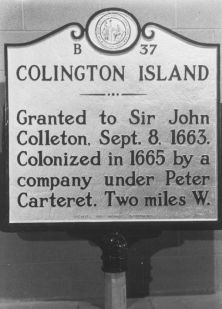
On September 8, 1663, the first transfer of land under the Lords Proprietors in Carolina took place. The grant was made to Sir John Colleton, himself one of the Lords Proprietors of Carolina.
The piece of land transferred was what was then called Carlyle or Colleton Island, and is now called Colington Island in Dare County. Colleton, a planter who also dabbled in business, finance and politics, already had large New World holdings in Barbados. Although he had returned to England in 1660, he had hopes of expanding his West Indies operations into the American colonies.
Colleton’s agent, Captain John Whittie, established a plantation on the property during the winter of 1664 and 1665. At first the island was used primarily for raising cattle and horses, but eventually crops including tobacco, corn and grapes were planted.
Whittie also eventually realized a profitable secondary source of income by selling oil extracted from whales that washed up on the shore. Peter Carteret, nephew of one of the proprietors and later governor of the colony, joined Colleton as a partner in the colonial venture. He arrived in the spring of 1665 to take charge of the plantation. Hurricanes, drought and floods plagued the settlement, which failed by the 1670s.
For more about North Carolina’s history, arts and culture, visit Cultural Resources online. To receive these updates automatically each day, make sure you subscribe by email using the box on the right, and follow us on Facebook, Twitter and Pinterest.
